Atherosclerosis
VerifiedAdded on 2023/04/20
|8
|2147
|119
AI Summary
This article discusses the causes, symptoms, and treatment of atherosclerosis, a focal disease that occurs primarily at sites of disturbed laminar flow. It explores the role of inflammation in the development of atherosclerosis and highlights the importance of lifestyle changes and medications in managing the condition.
Contribute Materials
Your contribution can guide someone’s learning journey. Share your
documents today.

Running head: ATHEROSCLEROSIS 1
Atherosclerosis
Name
Institution
Atherosclerosis
Name
Institution
Secure Best Marks with AI Grader
Need help grading? Try our AI Grader for instant feedback on your assignments.
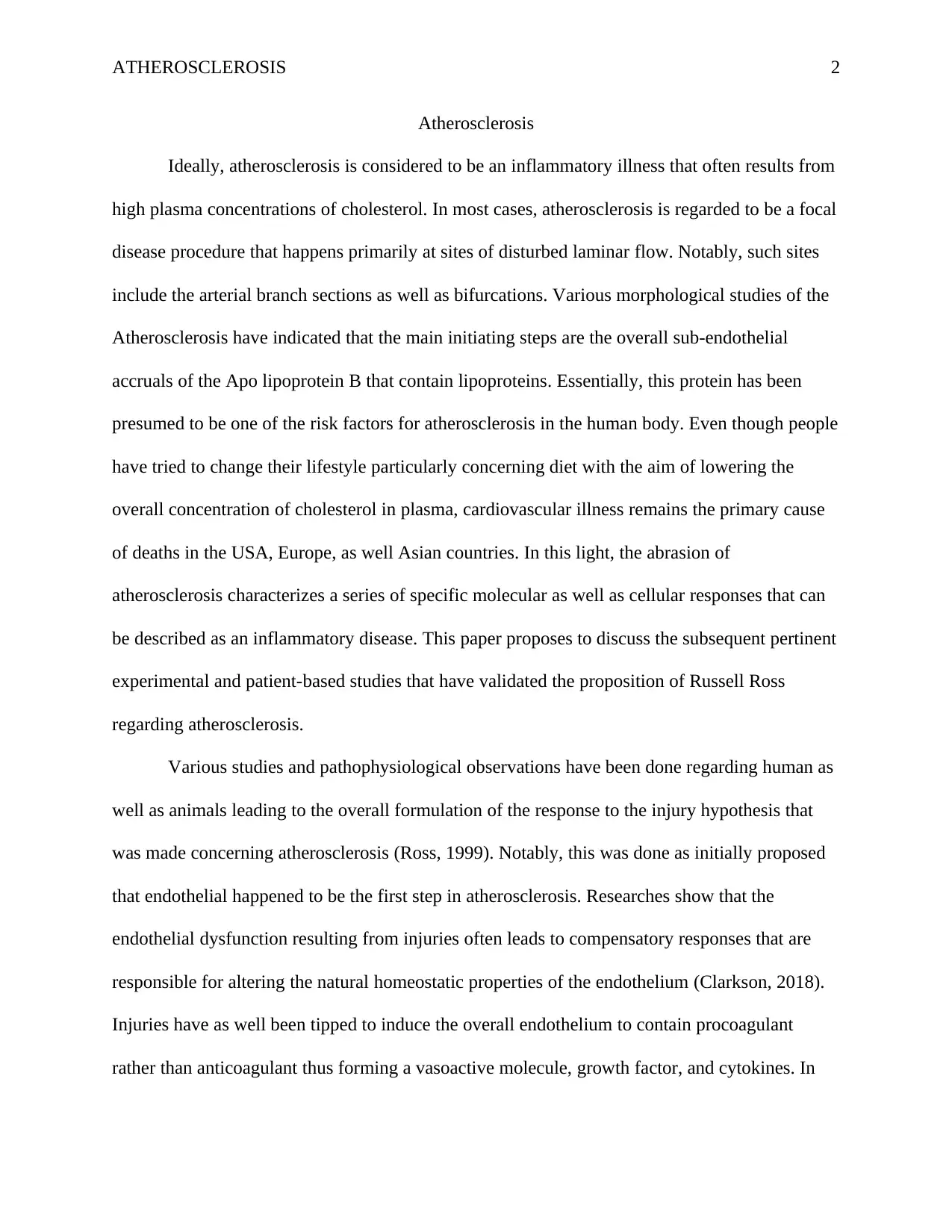
ATHEROSCLEROSIS 2
Atherosclerosis
Ideally, atherosclerosis is considered to be an inflammatory illness that often results from
high plasma concentrations of cholesterol. In most cases, atherosclerosis is regarded to be a focal
disease procedure that happens primarily at sites of disturbed laminar flow. Notably, such sites
include the arterial branch sections as well as bifurcations. Various morphological studies of the
Atherosclerosis have indicated that the main initiating steps are the overall sub-endothelial
accruals of the Apo lipoprotein B that contain lipoproteins. Essentially, this protein has been
presumed to be one of the risk factors for atherosclerosis in the human body. Even though people
have tried to change their lifestyle particularly concerning diet with the aim of lowering the
overall concentration of cholesterol in plasma, cardiovascular illness remains the primary cause
of deaths in the USA, Europe, as well Asian countries. In this light, the abrasion of
atherosclerosis characterizes a series of specific molecular as well as cellular responses that can
be described as an inflammatory disease. This paper proposes to discuss the subsequent pertinent
experimental and patient-based studies that have validated the proposition of Russell Ross
regarding atherosclerosis.
Various studies and pathophysiological observations have been done regarding human as
well as animals leading to the overall formulation of the response to the injury hypothesis that
was made concerning atherosclerosis (Ross, 1999). Notably, this was done as initially proposed
that endothelial happened to be the first step in atherosclerosis. Researches show that the
endothelial dysfunction resulting from injuries often leads to compensatory responses that are
responsible for altering the natural homeostatic properties of the endothelium (Clarkson, 2018).
Injuries have as well been tipped to induce the overall endothelium to contain procoagulant
rather than anticoagulant thus forming a vasoactive molecule, growth factor, and cytokines. In
Atherosclerosis
Ideally, atherosclerosis is considered to be an inflammatory illness that often results from
high plasma concentrations of cholesterol. In most cases, atherosclerosis is regarded to be a focal
disease procedure that happens primarily at sites of disturbed laminar flow. Notably, such sites
include the arterial branch sections as well as bifurcations. Various morphological studies of the
Atherosclerosis have indicated that the main initiating steps are the overall sub-endothelial
accruals of the Apo lipoprotein B that contain lipoproteins. Essentially, this protein has been
presumed to be one of the risk factors for atherosclerosis in the human body. Even though people
have tried to change their lifestyle particularly concerning diet with the aim of lowering the
overall concentration of cholesterol in plasma, cardiovascular illness remains the primary cause
of deaths in the USA, Europe, as well Asian countries. In this light, the abrasion of
atherosclerosis characterizes a series of specific molecular as well as cellular responses that can
be described as an inflammatory disease. This paper proposes to discuss the subsequent pertinent
experimental and patient-based studies that have validated the proposition of Russell Ross
regarding atherosclerosis.
Various studies and pathophysiological observations have been done regarding human as
well as animals leading to the overall formulation of the response to the injury hypothesis that
was made concerning atherosclerosis (Ross, 1999). Notably, this was done as initially proposed
that endothelial happened to be the first step in atherosclerosis. Researches show that the
endothelial dysfunction resulting from injuries often leads to compensatory responses that are
responsible for altering the natural homeostatic properties of the endothelium (Clarkson, 2018).
Injuries have as well been tipped to induce the overall endothelium to contain procoagulant
rather than anticoagulant thus forming a vasoactive molecule, growth factor, and cytokines. In
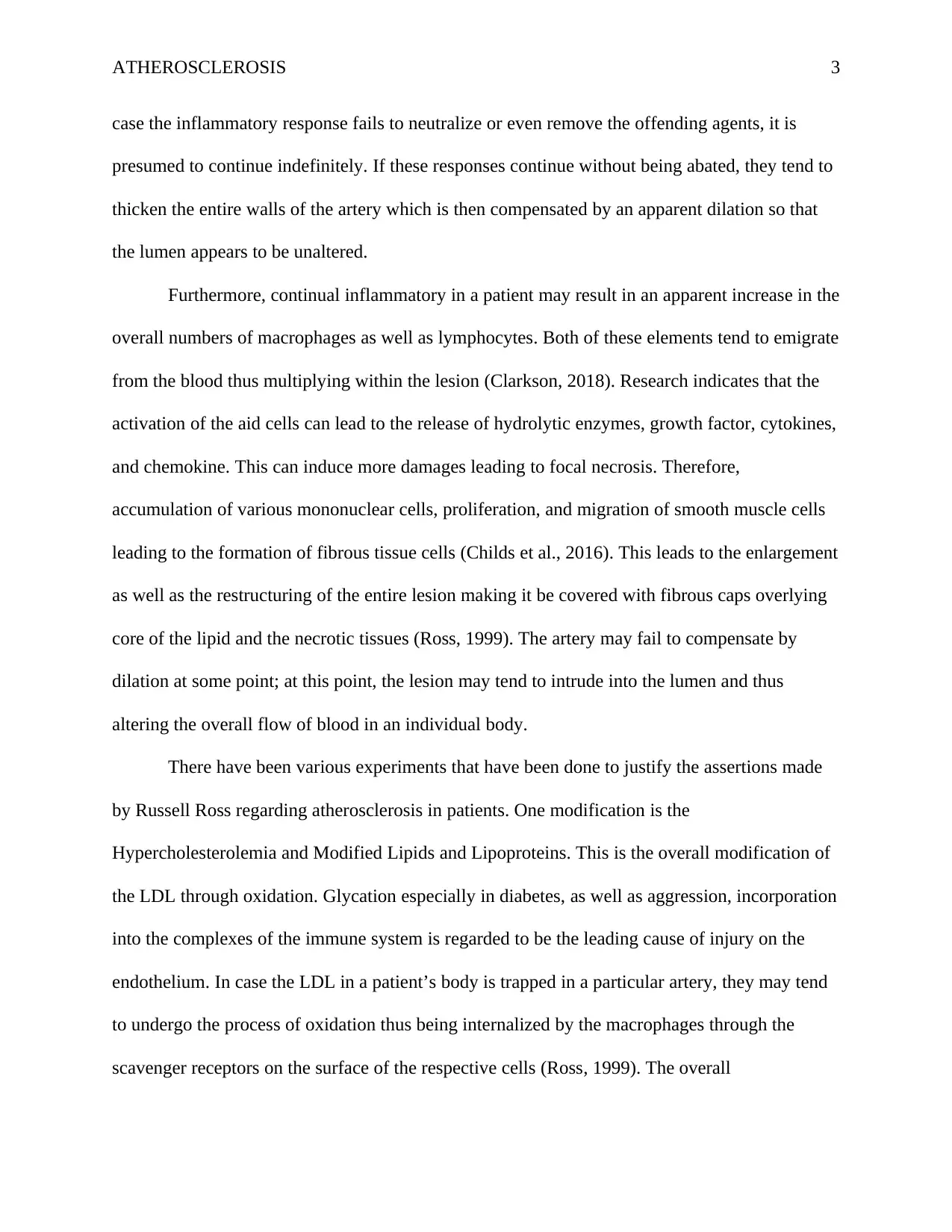
ATHEROSCLEROSIS 3
case the inflammatory response fails to neutralize or even remove the offending agents, it is
presumed to continue indefinitely. If these responses continue without being abated, they tend to
thicken the entire walls of the artery which is then compensated by an apparent dilation so that
the lumen appears to be unaltered.
Furthermore, continual inflammatory in a patient may result in an apparent increase in the
overall numbers of macrophages as well as lymphocytes. Both of these elements tend to emigrate
from the blood thus multiplying within the lesion (Clarkson, 2018). Research indicates that the
activation of the aid cells can lead to the release of hydrolytic enzymes, growth factor, cytokines,
and chemokine. This can induce more damages leading to focal necrosis. Therefore,
accumulation of various mononuclear cells, proliferation, and migration of smooth muscle cells
leading to the formation of fibrous tissue cells (Childs et al., 2016). This leads to the enlargement
as well as the restructuring of the entire lesion making it be covered with fibrous caps overlying
core of the lipid and the necrotic tissues (Ross, 1999). The artery may fail to compensate by
dilation at some point; at this point, the lesion may tend to intrude into the lumen and thus
altering the overall flow of blood in an individual body.
There have been various experiments that have been done to justify the assertions made
by Russell Ross regarding atherosclerosis in patients. One modification is the
Hypercholesterolemia and Modified Lipids and Lipoproteins. This is the overall modification of
the LDL through oxidation. Glycation especially in diabetes, as well as aggression, incorporation
into the complexes of the immune system is regarded to be the leading cause of injury on the
endothelium. In case the LDL in a patient’s body is trapped in a particular artery, they may tend
to undergo the process of oxidation thus being internalized by the macrophages through the
scavenger receptors on the surface of the respective cells (Ross, 1999). The overall
case the inflammatory response fails to neutralize or even remove the offending agents, it is
presumed to continue indefinitely. If these responses continue without being abated, they tend to
thicken the entire walls of the artery which is then compensated by an apparent dilation so that
the lumen appears to be unaltered.
Furthermore, continual inflammatory in a patient may result in an apparent increase in the
overall numbers of macrophages as well as lymphocytes. Both of these elements tend to emigrate
from the blood thus multiplying within the lesion (Clarkson, 2018). Research indicates that the
activation of the aid cells can lead to the release of hydrolytic enzymes, growth factor, cytokines,
and chemokine. This can induce more damages leading to focal necrosis. Therefore,
accumulation of various mononuclear cells, proliferation, and migration of smooth muscle cells
leading to the formation of fibrous tissue cells (Childs et al., 2016). This leads to the enlargement
as well as the restructuring of the entire lesion making it be covered with fibrous caps overlying
core of the lipid and the necrotic tissues (Ross, 1999). The artery may fail to compensate by
dilation at some point; at this point, the lesion may tend to intrude into the lumen and thus
altering the overall flow of blood in an individual body.
There have been various experiments that have been done to justify the assertions made
by Russell Ross regarding atherosclerosis in patients. One modification is the
Hypercholesterolemia and Modified Lipids and Lipoproteins. This is the overall modification of
the LDL through oxidation. Glycation especially in diabetes, as well as aggression, incorporation
into the complexes of the immune system is regarded to be the leading cause of injury on the
endothelium. In case the LDL in a patient’s body is trapped in a particular artery, they may tend
to undergo the process of oxidation thus being internalized by the macrophages through the
scavenger receptors on the surface of the respective cells (Ross, 1999). The overall
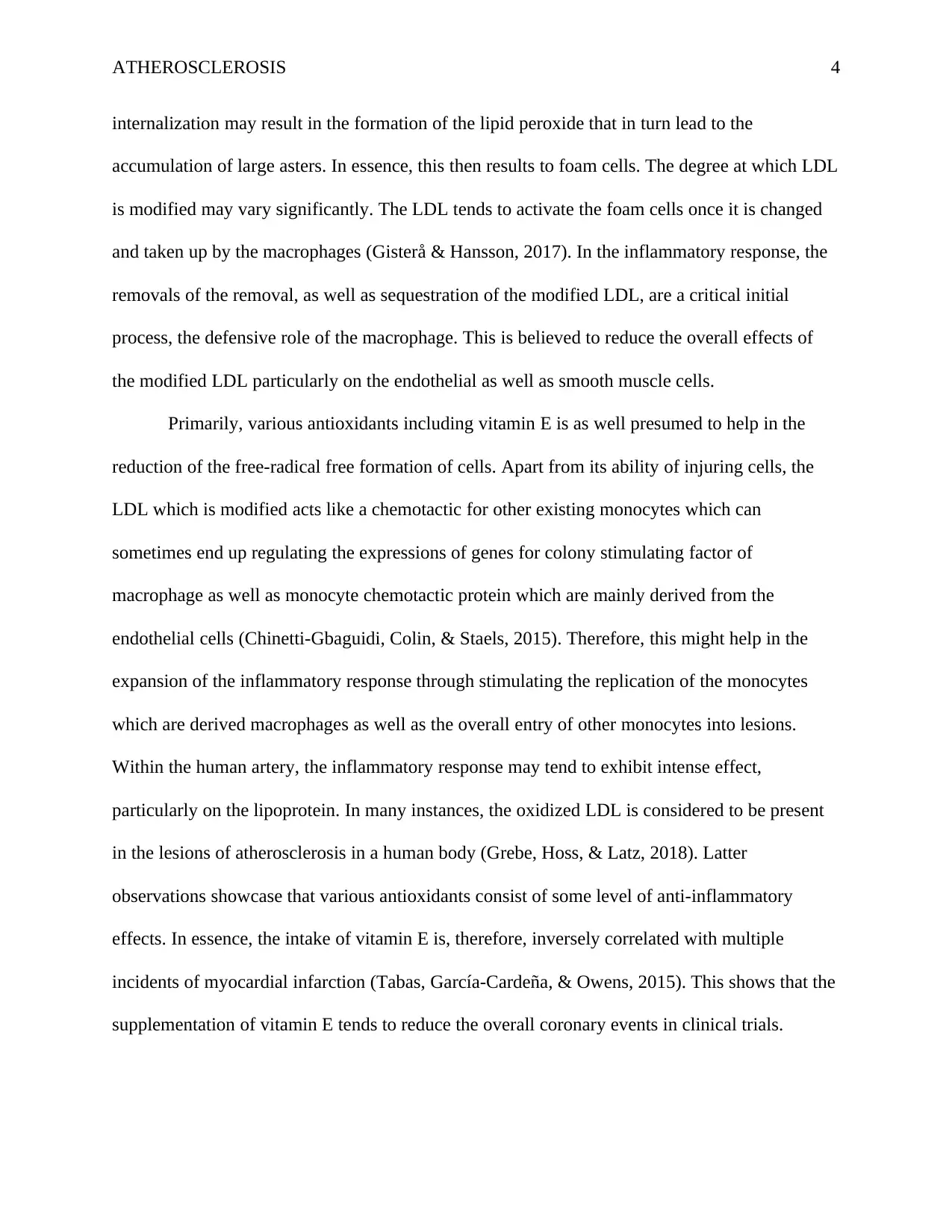
ATHEROSCLEROSIS 4
internalization may result in the formation of the lipid peroxide that in turn lead to the
accumulation of large asters. In essence, this then results to foam cells. The degree at which LDL
is modified may vary significantly. The LDL tends to activate the foam cells once it is changed
and taken up by the macrophages (Gisterå & Hansson, 2017). In the inflammatory response, the
removals of the removal, as well as sequestration of the modified LDL, are a critical initial
process, the defensive role of the macrophage. This is believed to reduce the overall effects of
the modified LDL particularly on the endothelial as well as smooth muscle cells.
Primarily, various antioxidants including vitamin E is as well presumed to help in the
reduction of the free-radical free formation of cells. Apart from its ability of injuring cells, the
LDL which is modified acts like a chemotactic for other existing monocytes which can
sometimes end up regulating the expressions of genes for colony stimulating factor of
macrophage as well as monocyte chemotactic protein which are mainly derived from the
endothelial cells (Chinetti-Gbaguidi, Colin, & Staels, 2015). Therefore, this might help in the
expansion of the inflammatory response through stimulating the replication of the monocytes
which are derived macrophages as well as the overall entry of other monocytes into lesions.
Within the human artery, the inflammatory response may tend to exhibit intense effect,
particularly on the lipoprotein. In many instances, the oxidized LDL is considered to be present
in the lesions of atherosclerosis in a human body (Grebe, Hoss, & Latz, 2018). Latter
observations showcase that various antioxidants consist of some level of anti-inflammatory
effects. In essence, the intake of vitamin E is, therefore, inversely correlated with multiple
incidents of myocardial infarction (Tabas, García-Cardeña, & Owens, 2015). This shows that the
supplementation of vitamin E tends to reduce the overall coronary events in clinical trials.
internalization may result in the formation of the lipid peroxide that in turn lead to the
accumulation of large asters. In essence, this then results to foam cells. The degree at which LDL
is modified may vary significantly. The LDL tends to activate the foam cells once it is changed
and taken up by the macrophages (Gisterå & Hansson, 2017). In the inflammatory response, the
removals of the removal, as well as sequestration of the modified LDL, are a critical initial
process, the defensive role of the macrophage. This is believed to reduce the overall effects of
the modified LDL particularly on the endothelial as well as smooth muscle cells.
Primarily, various antioxidants including vitamin E is as well presumed to help in the
reduction of the free-radical free formation of cells. Apart from its ability of injuring cells, the
LDL which is modified acts like a chemotactic for other existing monocytes which can
sometimes end up regulating the expressions of genes for colony stimulating factor of
macrophage as well as monocyte chemotactic protein which are mainly derived from the
endothelial cells (Chinetti-Gbaguidi, Colin, & Staels, 2015). Therefore, this might help in the
expansion of the inflammatory response through stimulating the replication of the monocytes
which are derived macrophages as well as the overall entry of other monocytes into lesions.
Within the human artery, the inflammatory response may tend to exhibit intense effect,
particularly on the lipoprotein. In many instances, the oxidized LDL is considered to be present
in the lesions of atherosclerosis in a human body (Grebe, Hoss, & Latz, 2018). Latter
observations showcase that various antioxidants consist of some level of anti-inflammatory
effects. In essence, the intake of vitamin E is, therefore, inversely correlated with multiple
incidents of myocardial infarction (Tabas, García-Cardeña, & Owens, 2015). This shows that the
supplementation of vitamin E tends to reduce the overall coronary events in clinical trials.
Secure Best Marks with AI Grader
Need help grading? Try our AI Grader for instant feedback on your assignments.
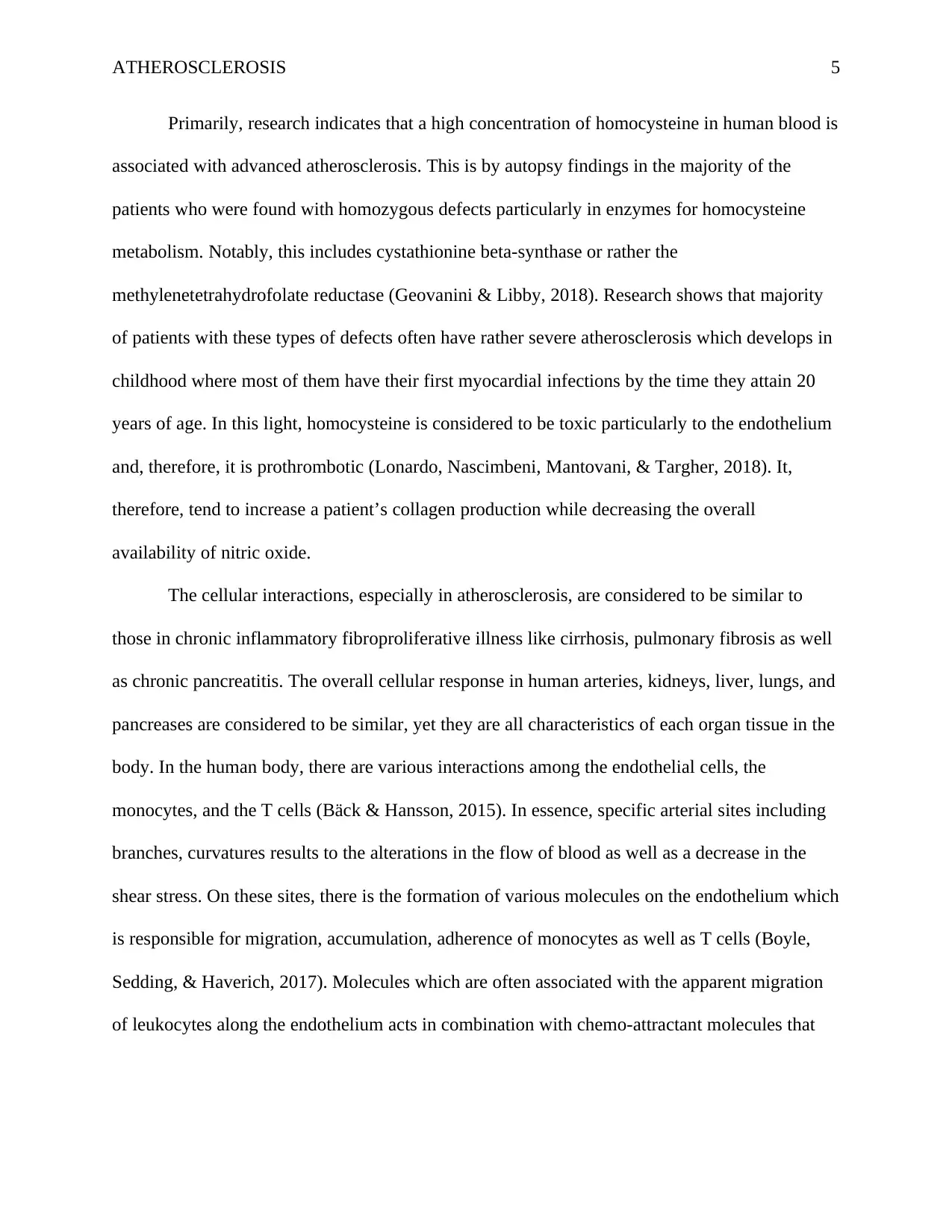
ATHEROSCLEROSIS 5
Primarily, research indicates that a high concentration of homocysteine in human blood is
associated with advanced atherosclerosis. This is by autopsy findings in the majority of the
patients who were found with homozygous defects particularly in enzymes for homocysteine
metabolism. Notably, this includes cystathionine beta-synthase or rather the
methylenetetrahydrofolate reductase (Geovanini & Libby, 2018). Research shows that majority
of patients with these types of defects often have rather severe atherosclerosis which develops in
childhood where most of them have their first myocardial infections by the time they attain 20
years of age. In this light, homocysteine is considered to be toxic particularly to the endothelium
and, therefore, it is prothrombotic (Lonardo, Nascimbeni, Mantovani, & Targher, 2018). It,
therefore, tend to increase a patient’s collagen production while decreasing the overall
availability of nitric oxide.
The cellular interactions, especially in atherosclerosis, are considered to be similar to
those in chronic inflammatory fibroproliferative illness like cirrhosis, pulmonary fibrosis as well
as chronic pancreatitis. The overall cellular response in human arteries, kidneys, liver, lungs, and
pancreases are considered to be similar, yet they are all characteristics of each organ tissue in the
body. In the human body, there are various interactions among the endothelial cells, the
monocytes, and the T cells (Bäck & Hansson, 2015). In essence, specific arterial sites including
branches, curvatures results to the alterations in the flow of blood as well as a decrease in the
shear stress. On these sites, there is the formation of various molecules on the endothelium which
is responsible for migration, accumulation, adherence of monocytes as well as T cells (Boyle,
Sedding, & Haverich, 2017). Molecules which are often associated with the apparent migration
of leukocytes along the endothelium acts in combination with chemo-attractant molecules that
Primarily, research indicates that a high concentration of homocysteine in human blood is
associated with advanced atherosclerosis. This is by autopsy findings in the majority of the
patients who were found with homozygous defects particularly in enzymes for homocysteine
metabolism. Notably, this includes cystathionine beta-synthase or rather the
methylenetetrahydrofolate reductase (Geovanini & Libby, 2018). Research shows that majority
of patients with these types of defects often have rather severe atherosclerosis which develops in
childhood where most of them have their first myocardial infections by the time they attain 20
years of age. In this light, homocysteine is considered to be toxic particularly to the endothelium
and, therefore, it is prothrombotic (Lonardo, Nascimbeni, Mantovani, & Targher, 2018). It,
therefore, tend to increase a patient’s collagen production while decreasing the overall
availability of nitric oxide.
The cellular interactions, especially in atherosclerosis, are considered to be similar to
those in chronic inflammatory fibroproliferative illness like cirrhosis, pulmonary fibrosis as well
as chronic pancreatitis. The overall cellular response in human arteries, kidneys, liver, lungs, and
pancreases are considered to be similar, yet they are all characteristics of each organ tissue in the
body. In the human body, there are various interactions among the endothelial cells, the
monocytes, and the T cells (Bäck & Hansson, 2015). In essence, specific arterial sites including
branches, curvatures results to the alterations in the flow of blood as well as a decrease in the
shear stress. On these sites, there is the formation of various molecules on the endothelium which
is responsible for migration, accumulation, adherence of monocytes as well as T cells (Boyle,
Sedding, & Haverich, 2017). Molecules which are often associated with the apparent migration
of leukocytes along the endothelium acts in combination with chemo-attractant molecules that
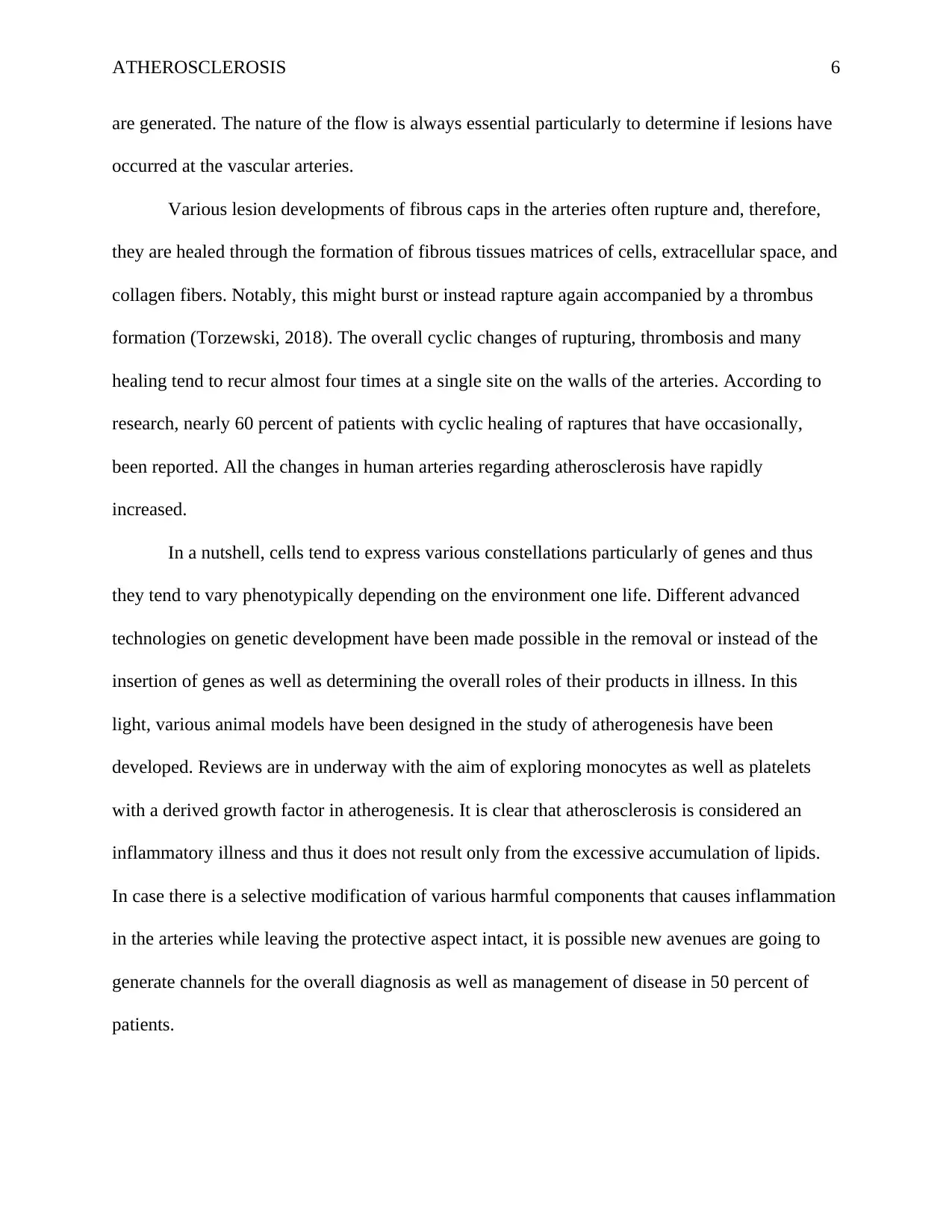
ATHEROSCLEROSIS 6
are generated. The nature of the flow is always essential particularly to determine if lesions have
occurred at the vascular arteries.
Various lesion developments of fibrous caps in the arteries often rupture and, therefore,
they are healed through the formation of fibrous tissues matrices of cells, extracellular space, and
collagen fibers. Notably, this might burst or instead rapture again accompanied by a thrombus
formation (Torzewski, 2018). The overall cyclic changes of rupturing, thrombosis and many
healing tend to recur almost four times at a single site on the walls of the arteries. According to
research, nearly 60 percent of patients with cyclic healing of raptures that have occasionally,
been reported. All the changes in human arteries regarding atherosclerosis have rapidly
increased.
In a nutshell, cells tend to express various constellations particularly of genes and thus
they tend to vary phenotypically depending on the environment one life. Different advanced
technologies on genetic development have been made possible in the removal or instead of the
insertion of genes as well as determining the overall roles of their products in illness. In this
light, various animal models have been designed in the study of atherogenesis have been
developed. Reviews are in underway with the aim of exploring monocytes as well as platelets
with a derived growth factor in atherogenesis. It is clear that atherosclerosis is considered an
inflammatory illness and thus it does not result only from the excessive accumulation of lipids.
In case there is a selective modification of various harmful components that causes inflammation
in the arteries while leaving the protective aspect intact, it is possible new avenues are going to
generate channels for the overall diagnosis as well as management of disease in 50 percent of
patients.
are generated. The nature of the flow is always essential particularly to determine if lesions have
occurred at the vascular arteries.
Various lesion developments of fibrous caps in the arteries often rupture and, therefore,
they are healed through the formation of fibrous tissues matrices of cells, extracellular space, and
collagen fibers. Notably, this might burst or instead rapture again accompanied by a thrombus
formation (Torzewski, 2018). The overall cyclic changes of rupturing, thrombosis and many
healing tend to recur almost four times at a single site on the walls of the arteries. According to
research, nearly 60 percent of patients with cyclic healing of raptures that have occasionally,
been reported. All the changes in human arteries regarding atherosclerosis have rapidly
increased.
In a nutshell, cells tend to express various constellations particularly of genes and thus
they tend to vary phenotypically depending on the environment one life. Different advanced
technologies on genetic development have been made possible in the removal or instead of the
insertion of genes as well as determining the overall roles of their products in illness. In this
light, various animal models have been designed in the study of atherogenesis have been
developed. Reviews are in underway with the aim of exploring monocytes as well as platelets
with a derived growth factor in atherogenesis. It is clear that atherosclerosis is considered an
inflammatory illness and thus it does not result only from the excessive accumulation of lipids.
In case there is a selective modification of various harmful components that causes inflammation
in the arteries while leaving the protective aspect intact, it is possible new avenues are going to
generate channels for the overall diagnosis as well as management of disease in 50 percent of
patients.
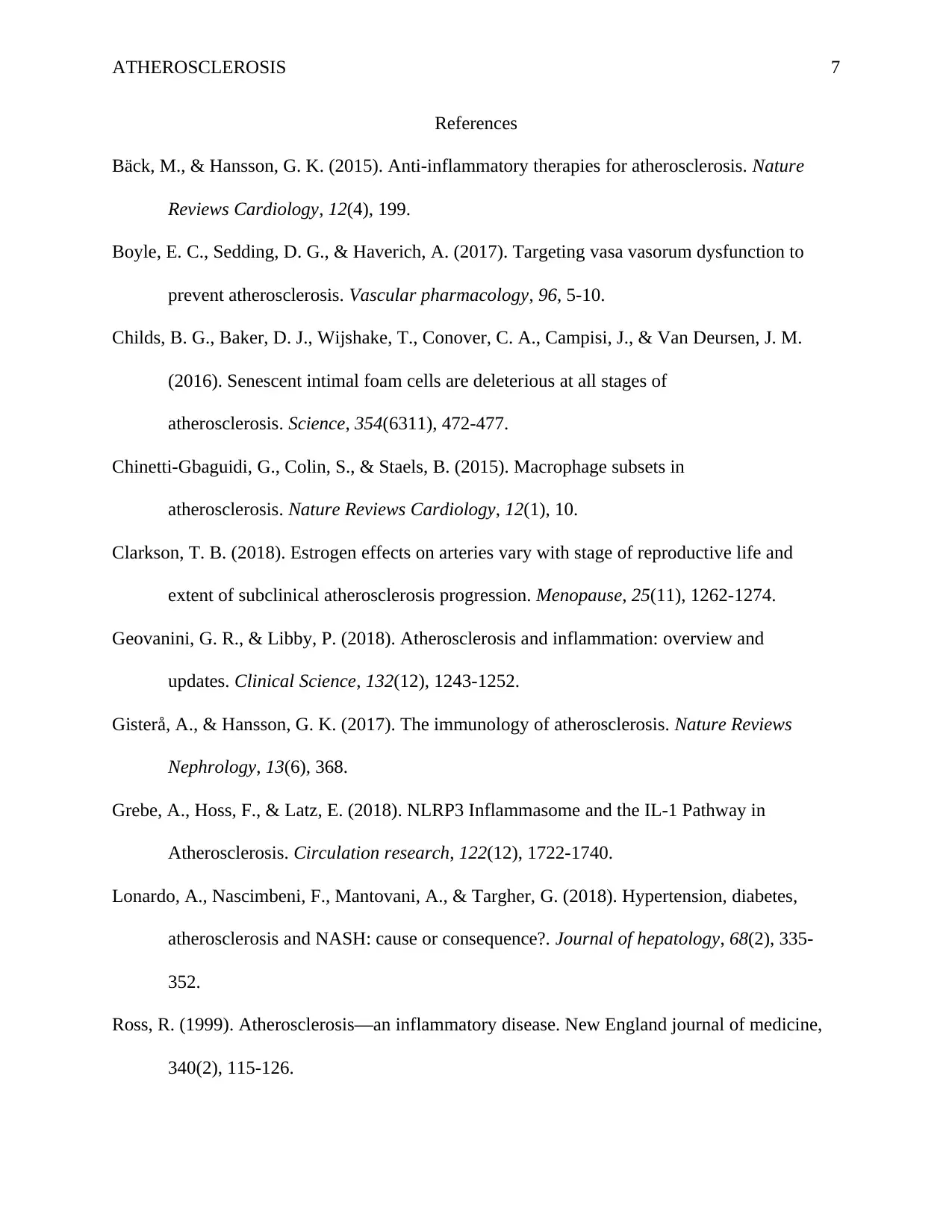
ATHEROSCLEROSIS 7
References
Bäck, M., & Hansson, G. K. (2015). Anti-inflammatory therapies for atherosclerosis. Nature
Reviews Cardiology, 12(4), 199.
Boyle, E. C., Sedding, D. G., & Haverich, A. (2017). Targeting vasa vasorum dysfunction to
prevent atherosclerosis. Vascular pharmacology, 96, 5-10.
Childs, B. G., Baker, D. J., Wijshake, T., Conover, C. A., Campisi, J., & Van Deursen, J. M.
(2016). Senescent intimal foam cells are deleterious at all stages of
atherosclerosis. Science, 354(6311), 472-477.
Chinetti-Gbaguidi, G., Colin, S., & Staels, B. (2015). Macrophage subsets in
atherosclerosis. Nature Reviews Cardiology, 12(1), 10.
Clarkson, T. B. (2018). Estrogen effects on arteries vary with stage of reproductive life and
extent of subclinical atherosclerosis progression. Menopause, 25(11), 1262-1274.
Geovanini, G. R., & Libby, P. (2018). Atherosclerosis and inflammation: overview and
updates. Clinical Science, 132(12), 1243-1252.
Gisterå, A., & Hansson, G. K. (2017). The immunology of atherosclerosis. Nature Reviews
Nephrology, 13(6), 368.
Grebe, A., Hoss, F., & Latz, E. (2018). NLRP3 Inflammasome and the IL-1 Pathway in
Atherosclerosis. Circulation research, 122(12), 1722-1740.
Lonardo, A., Nascimbeni, F., Mantovani, A., & Targher, G. (2018). Hypertension, diabetes,
atherosclerosis and NASH: cause or consequence?. Journal of hepatology, 68(2), 335-
352.
Ross, R. (1999). Atherosclerosis—an inflammatory disease. New England journal of medicine,
340(2), 115-126.
References
Bäck, M., & Hansson, G. K. (2015). Anti-inflammatory therapies for atherosclerosis. Nature
Reviews Cardiology, 12(4), 199.
Boyle, E. C., Sedding, D. G., & Haverich, A. (2017). Targeting vasa vasorum dysfunction to
prevent atherosclerosis. Vascular pharmacology, 96, 5-10.
Childs, B. G., Baker, D. J., Wijshake, T., Conover, C. A., Campisi, J., & Van Deursen, J. M.
(2016). Senescent intimal foam cells are deleterious at all stages of
atherosclerosis. Science, 354(6311), 472-477.
Chinetti-Gbaguidi, G., Colin, S., & Staels, B. (2015). Macrophage subsets in
atherosclerosis. Nature Reviews Cardiology, 12(1), 10.
Clarkson, T. B. (2018). Estrogen effects on arteries vary with stage of reproductive life and
extent of subclinical atherosclerosis progression. Menopause, 25(11), 1262-1274.
Geovanini, G. R., & Libby, P. (2018). Atherosclerosis and inflammation: overview and
updates. Clinical Science, 132(12), 1243-1252.
Gisterå, A., & Hansson, G. K. (2017). The immunology of atherosclerosis. Nature Reviews
Nephrology, 13(6), 368.
Grebe, A., Hoss, F., & Latz, E. (2018). NLRP3 Inflammasome and the IL-1 Pathway in
Atherosclerosis. Circulation research, 122(12), 1722-1740.
Lonardo, A., Nascimbeni, F., Mantovani, A., & Targher, G. (2018). Hypertension, diabetes,
atherosclerosis and NASH: cause or consequence?. Journal of hepatology, 68(2), 335-
352.
Ross, R. (1999). Atherosclerosis—an inflammatory disease. New England journal of medicine,
340(2), 115-126.
Paraphrase This Document
Need a fresh take? Get an instant paraphrase of this document with our AI Paraphraser

ATHEROSCLEROSIS 8
Tabas, I., García-Cardeña, G., & Owens, G. K. (2015). Recent insights into the cellular biology
of atherosclerosis. J Cell Biol, 209(1), 13-22.
Torzewski, M. (2018). Enzymatically modified LDL, atherosclerosis and beyond: paving the
way to acceptance. Frontiers in bioscience (Landmark edition), 23, 1257-1271.
Tabas, I., García-Cardeña, G., & Owens, G. K. (2015). Recent insights into the cellular biology
of atherosclerosis. J Cell Biol, 209(1), 13-22.
Torzewski, M. (2018). Enzymatically modified LDL, atherosclerosis and beyond: paving the
way to acceptance. Frontiers in bioscience (Landmark edition), 23, 1257-1271.
1 out of 8
Your All-in-One AI-Powered Toolkit for Academic Success.
+13062052269
info@desklib.com
Available 24*7 on WhatsApp / Email
![[object Object]](/_next/static/media/star-bottom.7253800d.svg)
Unlock your academic potential
© 2024 | Zucol Services PVT LTD | All rights reserved.
